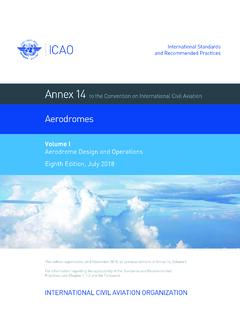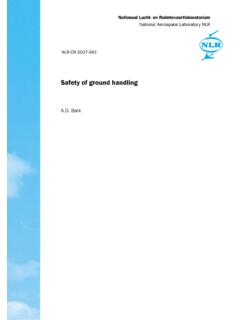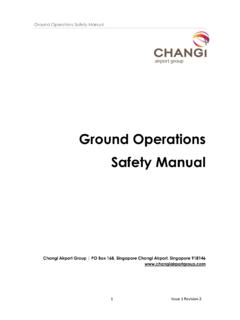Transcription of Unit 30: Aircraft Marshalling - Edexcel
1 1 Aircraft Marshalling Pearson BTEC Nationals (QCF) specifi cation in Aviation Operations Issue 2 November 2019 Pearson Education Limited 2012 Unit 30: Aircraft MarshallingUnit code: L/601/6487 QCF Level 2: BTEC FirstCredit value: 2 Guided learning hours: 16 Aim and purposeThe aim of this unit is to enable the learner to develop the necessary knowledge and understanding of the principles of Aircraft Marshalling . This will enable the learner to be able to safely marshal an Aircraft onto, or off , a stand. The knowledge provided within this unit is fundamental to all activities within the airport environment. This unit is appropriate (but not obligatory) for all learners prior to them undertaking activities introductionAs an Aircraft taxis onto its parking stand, the Aircraft marshaller is performing a vital safety function in this crucial stage of the arrival are designed to perform at their best when travelling at high speed, several thousand feet above the ground.
2 Their ability to manoeuvre is severely limited when negotiating the congested taxiway and ramp network of a busy airport. Equally, the view from the cockpit can be limited; often the wing tips are very diffi cult for fl ight deck crew to see. As a consequence, some form of guidance is usually provided for the fi nal act of Aircraft parking. Not only does the Aircraft marshaller provide this guidance, they are also responsible for checking that the parking stand is suitable for accommodating the Aircraft . Checks must be made to ensure there is no debris on the stand, that no vehicles have been left in dangerous locations and that boarding or disembarking passengers are not going to be endangered by the approaching the checks have been carried out, the marshaller must use clear and confi dent signals to guide the Aircraft safely, Aircraft Marshalling can be one of the more rewarding job roles on the ramp. Each arrival is slightly diff erent, each with its own challenges to outcomesOn completion of this unit a learner should:1 Understand how to prepare for Aircraft arrival on stand2 Be able to marshal Aircraft onto and off Marshalling Pearson BTEC Nationals (QCF) specifi cation in Aviation Operations Issue 2 November 2019 Pearson Education Limited 20122 Unit content1 Understand how to prepare for Aircraft arrival on standPurpose of Marshalling : safety, to Aircraft , to ground staff , to passengers guidance, correct stand, correct stopping pointDangers of Marshalling : noise ingestion blast vehicle collision dustForeign object debris (FOD): from engineering activities, tools, nuts and bolts, oil cans from caterers, food, cutlery, cups, bar seals from loading activities, wheels and studs from suitcases, handles from suitcases, lashing straps other, litterChecks before bringing Aircraft onto stand.
3 Stand unoccupied by other Aircraft clear of equipment, tug, conveyor, bag cart, container dolley, chocks free of contamination, FOD, oil/fuel spill activities on adjacent stands, boarding/disembarking passengers, service equipmentMarshalling aids: manual, bats, illuminated wands, hi-vis gloves mechanical, airport automatic parking systems additional aids, follow-me vehicle, wing tip guideWeather: fog, use of follow-me vehicle, series of marshallers, wing tip guidance personal precautions, in high wind, ice and snowPPE used by marshallers: ear defenders hi-vis clothing weather protection goggles protective footwear3 Aircraft Marshalling Pearson BTEC Nationals (QCF) specifi cation in Aviation Operations Issue 2 November 2019 Pearson Education Limited 20122 Be able to marshal Aircraft onto and off standHand signals: marshaller to fl ight deck fl ight deck to marshaller standard signals emergency signalsRules, regulation and signals: Civil Aviation Publication CAP637 (Visual Signals Handbook) Rules of the Air Regulations Marshalling signals (this stand, straight ahead, turn left/right, stop, chocks inserted, ground power attached, clear to start engine, disconnect ground power, chocks away, cleared to depart the stand)Actions to make an Aircraft safe: chocks in engine shut down anti-collision beacon off propellers secured (if applicable)Actions prior to departure: chocks in position steps away hold doors checked FOD check clear behind ground power unit (GPU) functioning (if required) engine start GPU unplugged chocks awayAircraft Marshalling Pearson BTEC Nationals (QCF) specifi cation in Aviation Operations Issue 2 November 2019 Pearson Education Limited 20124 Assessment and grading criteriaIn order to pass this unit, the evidence that the learner presents for assessment needs to demonstrate that they can meet all the learning outcomes for the unit.
4 The assessment criteria for a pass grade describe the level of achievement required to pass this and grading criteriaTo achieve a pass grade the evidence must show that the learner is able to:To achieve a merit grade the evidence must show that, in addition to the pass criteria, the learner is able to:To achieve a distinction grade the evidence must show that, in addition to the pass and merit criteria, the learner is able to:P1 Explain the purpose of Aircraft marshallingM1 Illustrate the procedures used to bring an Aircraft onto and off stand safely in diff erent weather conditions D1 Analyse the consequences of non-compliance with regulations and safety checks when bringing an Aircraft onto and off standP2 Describe the dangers of carrying out Marshalling duties [RL]P3 Identify diff erent types of foreign object Debris (FOD)P4 Describe the checks required before bringing Aircraft to the standP5 Identify diff erent types of Marshalling aidsP6 Explain how weather conditions can aff ect the Marshalling procedure [IE]P7 Describe Personal Protective Equipment (PPE)
5 Used in the Marshalling process P8 Use correct hand signals to marshal Aircraft onto and off stand [TW, EP]M2 Use Marshalling aids to demonstrate bringing an Aircraft onto and off stand safely during set scenarios, evaluating own performanceP9 Describe the rules, regulations and signals of Marshalling an aircraftP10 Describe the actions required to make an Aircraft safe prior to personnel approachingP11 Describe the actions required prior to Aircraft departure5 Aircraft Marshalling Pearson BTEC Nationals (QCF) specifi cation in Aviation Operations Issue 2 November 2019 Pearson Education Limited 2012 PLTS: This summary references where applicable, in the square brackets, the elements of the personal, learning and thinking skills applicable in the pass criteria. It identifi es opportunities for learners to demonstrate eff ective application of the referenced elements of the independent enquirersCT creative thinkersRL refl ective learners TW team workersSM self-managersEP eff ective participatorsAircraft Marshalling Pearson BTEC Nationals (QCF) specifi cation in Aviation Operations Issue 2 November 2019 Pearson Education Limited 20126 Essential guidance for tutorsDeliveryAirside visits are diffi cult to arrange.
6 Watching an Aircraft marshaller in action is by far the best way to appreciate the skills and confi dence required to perform the task. However, for most learners input is likely to take place in the classroom or even the centre s car park. There are many YouTube video clips of Aircraft Marshalling and these can be used to great eff ect when demonstrating the required hand signals. However, tutors should choose the clips with care, some (especially the military versions) are a humorous look at the skill not to be adopted in civilian aviation! As suggested for other units, a day return fl ight could be advantageous in giving learners an opportunity to observe Marshalling from the gate, as they embark or on landing. However, observation cannot be guaranteed. A good starting point would be the regulations and conventions why do we need marshallers and what rules do they follow? A group discussion investigating the fi nal elements of the arrival phase of an Aircraft as it taxis from the runway should bring to light potential hazards such as poor manoeuvrability, reduced vision from the cockpit and diffi culties assessing wing tip clearance.
7 This should fl ow into how the Marshalling system can reduce these hazards. The process should be approached logically. Start with the preparation; the stand must be checked to ensure it is safe to accept the Aircraft . Suggested obstacles are found in the unit content, but it is likely learners will think of additional debris. Once satisfi ed that the stand is safe, the marshaller must guide the Aircraft to its required stopping position. A look through Visual Signals handbooks should show all the signals. As there are a large number of signals, it would be benefi cial to highlight the more frequently used, such as this stand, straight ahead, turn left/right, stop, chocks in place, together with the signals for cut engines and engine fi re. At this stage, learners should be made aware that, at some airports, marshallers are also used during the pushback/power-back manoeuvre off stand. The departure signals are also found in relevant Visual Signals above assumes daylight Marshalling in good visibility.
8 It is important to point out that both night and adverse weather can change procedures. Illuminated wands are used to increase the visibility of the guidance gestures, and in extreme conditions a follow-me vehicle may be used in place of a static the potential hazards of the marshaller s role with the PPE provided should contextualise the risks and how they are contained. The unit content contains an indicative list of actions must be taken to make an Aircraft safe for others to approach following arrival on stand. Local rules and conventions will dictate who is responsible for what action, but frequently the marshaller will be involved in at least some of them. Equally, the reverse is the case when an Aircraft is ready to depart the stand. A list is found for both in the unit content, any signals being found in relevant Visual Signals handbooks such as part that most learners will have been looking forward to is a practical session involving use of hand signals for arriving and departing Aircraft .
9 Obviously it is impractical to marshall real Aircraft in this context, so fellow learners may have to act as Aircraft , while the learner being assessed is the marshaller. This may be diffi cult to control within the classroom, so a large area such as a playing fi eld or car park could be used. This should be marked up to represent standard ramp markings. It may be useful for learners to prepare A4 cards indicating each of the required signals, which can be shown in turn. These can help to raise awareness of the types of signal marshallers use, and can also be used during the practical extend their knowledge and ability learners should be given the opportunity to demonstrate the above role play using specifi c Marshalling aids. This could include bats, illuminated wands, hi-vis jackets and hi-vis role play could be videoed giving learners the opportunity to view their performance, and make recommendations as to how it could have been Marshalling Pearson BTEC Nationals (QCF) specifi cation in Aviation Operations Issue 2 November 2019 Pearson Education Limited 2012 Learners should be given the opportunity to analyse what could happen when safety checks and regulations are not carried out on the ramp.
10 There are many checks that need to be complied with, however learners need to understand the implications of what goes wrong if any of these are missed. Group discussions or debates would be a good way to achieve a higher level of learning planThe outline learning plan has been included in this unit as guidance and can be used in conjunction with the programme of suggested outline learning plan demonstrates one way of planning the delivery and assessment of this unit. Topic and suggested assignments/activities and/assessmentIntroduction to Aircraft Marshalling including an explanation of the unit to be introduced to the indicative reading material, including books, internet, journals clips (make sure that the clips used are displaying a serious view of the skill).Introduction to Assignment why do we need marshallers? What rules do they follow?Mind mapping exercise investigating the potential hazards/dangers associated with Aircraft Marshalling ( poor manoeuvrability, reduced vision from the cockpit and diffi culties assessing wing tip clearance).

















